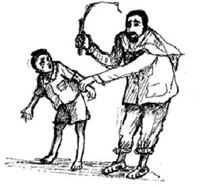Child abuse
Child abuse is a very difficult issue to deal with. This is partly because aspects of abuse are common due to a poor understanding of its impact on the child. As a health professional working with the community, it is important that you understand what child abuse is and explain to others the negative impact of this practice on children. You will then be able to teach the community about healthy childrearing.
Child abuse can be defined as the mistreatment of a child that adversely affects the child's health and development. There are three main types of abuse: physical abuse, emotional abuse and sexual abuse.

Physical abuse occurs when a child is frequently and severely punished (Figure 17.5) so that damage is caused to the child's emotional or physical health. Sometimes children may be punished or beaten so severely that they sustain serious injuries including broken bones.
Emotional abuse is the commonest form of abuse and can take different forms. It may involve verbal abuse, in which the child is frequently shouted at, mocked and insulted. It may also involve treating one child preferentially while ignoring another. Neglect (in which the child does not receive sufficient love or affection) is another form of emotional abuse that may have very negative consequences for the child's development.
Sexual abuse occurs when an adult uses a child for sexual pleasure. The adult may touch the child's sexual organs, make the child touch their sexual organs, or even try to have sexual intercourse with the child.
All these forms of abuse, particularly sexual abuse, may have a lasting emotional impact.